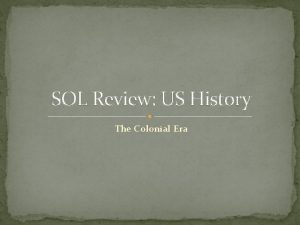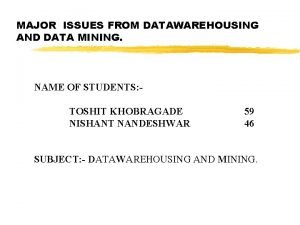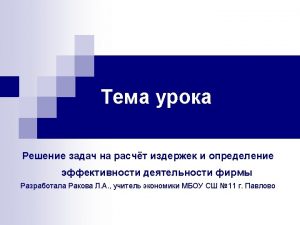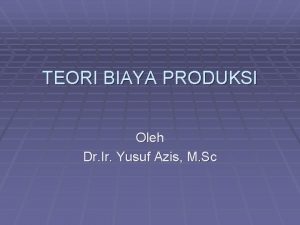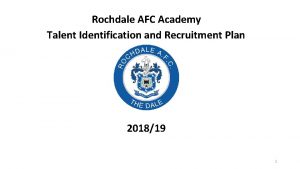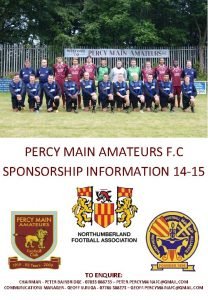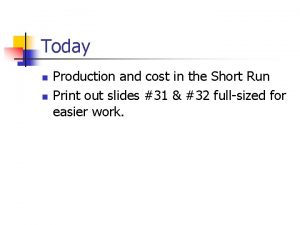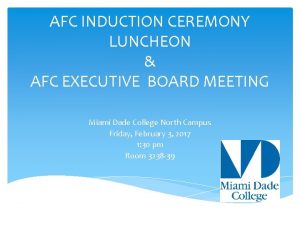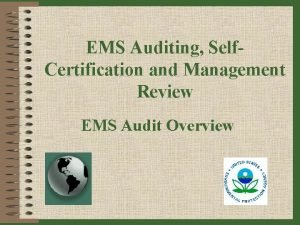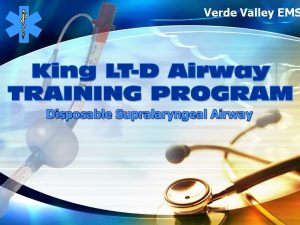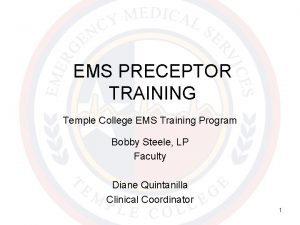AFC METHODOLOGY AFC New Developments EMS USER GROUP

















- Slides: 17

AFC METHODOLOGY AFC – New Developments EMS USER GROUP Sep 12 2004 EMS USER GROUP SEP 12, 2004

AFC METHODOLOGY WHAT IS AVAILABLE FLOWGATE CAPACITY • Available Flowgate Capacity or AFC is a flowbased approach to determine the availability of transmission capacity. This approach predicts and analyzes flows on constrained facilities (called “flowgates”) when determining whether sufficient capacity exists to approve a transmission service request. • The AFC value for a particular flowgate is the amount of transfer capability over that flowgate that remains available for additional transmission service reservations above and beyond existing uses of the transmission system. EMS USER GROUP SEP 12, 2004

AFC METHODOLOGY FLOWGATE A single or group of Transmission elements intended to model MW flow impact related to transmission limitation and transmission system usage. PTDF FLOWGATE: When the monitored elements are monitored without considering the impact of any contingency. OTDF FLOWGATE: When the monitored elements are monitored after considering the impact of one or more outages. EMS USER GROUP SEP 12, 2004

AFC METHODOLOGY RESPONSE FACTORS Line Outage Distribution Factor (LODF): Defines the impact of contingent element/s on monitored element/s in terms of percentage of MW flow. Power Transfer Distribution Factor (PTDF): Defines the impact of a transfer on a flowgate, in terms of percentage of MW amount of transfer. PTDFfg = PTDFle + LODF * PTDFce EMS USER GROUP SEP 12, 2004

AFC METHODOLOGY EMS USER GROUP SEP 12, 2004

AFC METHODOLOGY AFC Horizons Operating Horizon: Includes all hours of current day and after 12: 00 PM includes all hours of next day. Hourly values are calculated for this horizon. Planning Horizon: Extends from end of operating horizon to 31 st Day. Hourly values are calculated for 1 st seven days and daily values are calculated for the rest. Study Horizon: Extends from end of planning horizon to month 18. Monthly values are computed for this horizon. EMS USER GROUP SEP 12, 2004

AFC METHODOLOGY AFC CALCULATIONS Model Building • Outages • planned generation • Load Forecast • Confirmed Firm schedules • Accepted, Confirmed and Counteroffer reservations (firm and non firm) Power Flow Solution Power flow is performed for all hourly and daily time points. The Output of power flow is: EMS USER GROUP SEP 12, 2004

AFC METHODOLOGY AFC CALCULATIONS Power flow Output: • Flowgate flows for all flowgates all time points • Sensitivities of top 15 flow gates for each transfer path EMS USER GROUP SEP 12, 2004

AFC METHODOLOGY AFC CALCULATIONS AFC Formulas: Firm AFC = Rating – TRM –CBM – Base Flowfirm Non Firm AFC = Rating – TRM –CBM – Base Flownon-firm Base Flow : Base flow calculation for Firm AFC takes into account all existing firm use of transmission system including • Firm PTP • Service to Network and Native Load Customers • Other Firm Transmission service such as granfathered agreements pre FERC order 888. EMS USER GROUP SEP 12, 2004

AFC METHODOLOGY RESYNCHRONIZATION Operating horizon: every hour. Planning horizon: every six hours. Study Horizon: Every month During RFCALC resynchronization models are built for each hour and Power flow is performed. During Oasis Automation Resynchronization it retrieves all sensitivities and base flows from RFCALC. EMS USER GROUP SEP 12, 2004

AFC METHODOLOGY IN BETWEEN RESYNCHRONIZATION Algebraic adjustments are done to AFCs, using sensitivity factors. Reevaluation and Reclamation: When an status change event occurs like a reservation changes from accepted to withdrawn all impacted reservations are reevaluated. AFC may be reclaimed on affected flowgates if necessary. . EMS USER GROUP SEP 12, 2004

AFC METHODOLOGY SINGLE SOURCE CONCEPT • Response Factors measure the impact (i. e. , the incremental loading) that each source-to-sink transaction has on a monitored flowgate. • Response Factors are transaction-specific in the sense that each source-to-sink pair will have a set of Response Factors based on the power flows associated with that source-to-sink pair. • Response Factors are flowgate-specific in the sense that every source-to-sink transaction will have a distinct Response Factor for each monitored flowgate. • Entergy calculates Response Factors for each generator that is directly interconnected with the Entergy transmission system, including all generators within the Entergy control area, EMS USER GROUP SEP 12, 2004 regardless of ownership or affiliation

AFC METHODOLOGY GENERATOR and INTERFACE LIMITS • Regardless of the applicable AFC values, accepted transmission service requests from a particular generator shall not exceed the maximum output of that generator. • The amount of transmission service available across a control area interface can not exceed the total interface rating between the two control areas. Consistent with NERC Operating Policies and operating agreements, the capacity between these interfaces is rated. This limit is typically defined by thermal limit of all transmission facilities that define the interface. • Pmax and Interface limits are honored by proxy flowgates. EMS USER GROUP SEP 12, 2004

AFC METHODOLOGY COUNTERFLOWS • Power flow solution includes 100% counterflows. • To account for uncertainty that the counterflow transactions will be actually scheduled we remove a percentage of counterflow from base flow. . . EMS USER GROUP SEP 12, 2004

AFC METHODOLOGY COUNTERFLOWS NON FIRM PTP X’ Impact X’ NON FIRM PTP X Impact X . NON FIRM Network Y’ Y’Impact. Y’ NON FIRM Network Y Impact Y Flowgate 1 EMS USER GROUP SEP 12, 2004 Counterflo w

AFC METHODOLOGY COUNTERFLOW CALCULATION • Within RFCALC, for each Flowgate determine the transfer paths with negative sensitivity above a threshold. • Of this list determine the paths which have a reservation which was modeled in base case. • Determine the counterflow adjustment by using sensitivities and counterflow factors. • Firm Service : Include 50% CF • Non Firm Service: Include 70% CF. . EMS USER GROUP SEP 12, 2004 .

AFC METHODOLOGY ? QUESTIONS . EMS USER GROUP SEP 12, 2004
 In the colonial era developments such as the new england
In the colonial era developments such as the new england Marketo certified specialist
Marketo certified specialist Mining methodology and user interaction issues
Mining methodology and user interaction issues Single user and multiple user operating system
Single user and multiple user operating system Single user and multiple user operating system
Single user and multiple user operating system Fill the blank space
Fill the blank space Tc = avc + afc
Tc = avc + afc Afc avc atc mc table
Afc avc atc mc table Tc avc
Tc avc Q fc vc tc afc avc atc mc
Q fc vc tc afc avc atc mc Dayone ss2
Dayone ss2 Tabel tfc tvc tc afc avc, ac mc
Tabel tfc tvc tc afc avc, ac mc Afc 500
Afc 500 Fa talent identification course
Fa talent identification course Percy main amateurs fc
Percy main amateurs fc Vertical distance between atc and avc
Vertical distance between atc and avc Jeannette jara roman
Jeannette jara roman Recent developments in ict
Recent developments in ict
